|
| |
FAMILY SCARABAEIDAE
- This page contains information and pictures about Rhinoceros Beetles that we
found in the Brisbane area, Queensland, Australia.
-
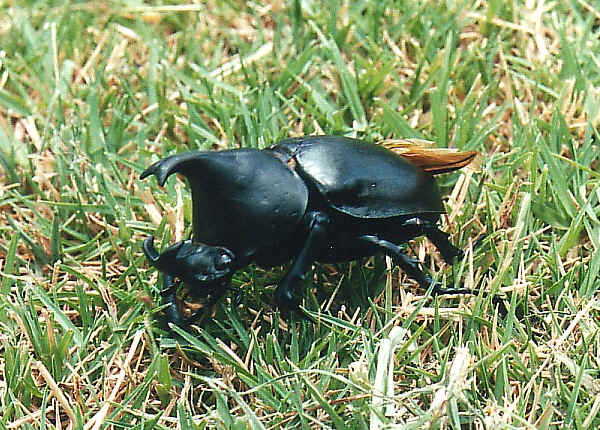 - Male, body length 45mm
-
- The rhinoceros beetles also commonly known as Elephant Beetles.
They belong to the Scarab family. Scarab beetles have special antennae with fans
on their tips. The rhinoceros beetle is the largest of all beetles and is named
that because the males generally have notable horns on the front end of the
body.
-
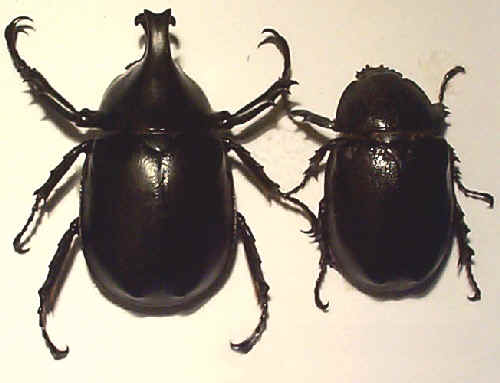 Male
(left) and female (right) Male
(left) and female (right) -
- This beetle can be found in south-east Asia, the islands of Indonesia, the
Solomons and Australia. It is often founding suburban areas of Queensland's
coastal towns, including Brisbane. They can be seen lying under street lights
during summer months in Brisbane but can be found at any time of the year in the
tropical north. Rhinoceros beetles are also seen in large groups on Poinciana
trees.
-
- The rhinoceros beetle is 60mm in length and is recognised by the large horns
on its front. This black beetle uses its horns to try to knock other males off a
tree when they smell a female. They also make hissing squeaks when disturbed.
These hissing sounds are made by rubbing the abdomen against the wing covers.
Rhinoceros beetles are actually quite harmless; as long as you avoid the sharp
claws on the end of their legs. Only male have horns. Females are quite plain
and seen less often. It is also thought that the large gatherings on the
Poinciana trees are part of the beetles mating behaviour
-
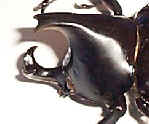 A A 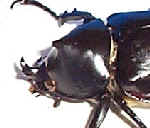 B B 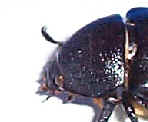 C
C- A, B, same profile of head and thorax showing variation in male. C, head and
thorax of female.
-
-
- The rhinoceros beetle larvae ( grub ) hatches from eggs and develop into
pupae and the pupae eventually develop into a beetle. A female lays about 50
white eggs in decaying vegetable matter. The eggs take about three weeks to
hatch and when the larvae has hatched it feeds on the decaying vegetable matter.
In Brisbane, it is thought that this beetle requires up to two years to grow
into the full size. The rhinoceros beetle's larvae is easily recognised by its
transparent grey, its fine reddish down, its dark brown head and its enormous
size-almost filling the palm of an hand. When the larvae is full grown, it forms
a cell in the soil and lines it with faeces which solidifies into a waterproof
layer. The adult beetle hatches out and digs its way to the surface after about
a month. The adult lives for about 2-4 months.
-
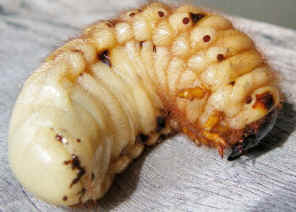 - Photo thank to Colin Burt in Hervey Bay
-
- Colin sent us the above photo on Apr 2010. He advised that: "The large white 'grub' found in soil on digging and in pile of mulch when turned over. Has quite a powerful nip when picked up ! So far no sign of any damage after seven years of living here."
-
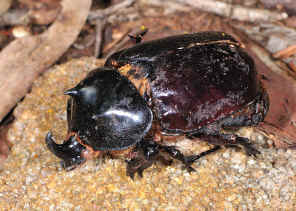 - Found this dry body near the White Rock on 2011. Notice the variation of
the prothorax.
-
- The beetles sometimes can be found under and around the street light in
Brisbane during mid summer.
-
- (Text by Sandy Chew, 2001)
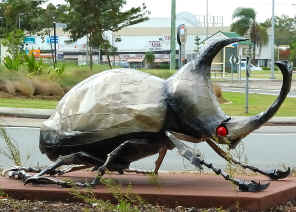
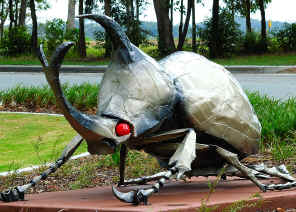 - This very large Rhinoceros Beetle is in Oxenford, the way to Tamborine
National Park.
- Reference:
- 1. Wildlife of Greater Brisbane
- Ryan, Michelle (ed.), Queensland Museum, Brisbane, 1995, p.90.
- 2. Insects
of Australia, CSIRO, Division of Entomology, Melbourne University
Press, 2nd Edition 1991, p 630.
- 3. Beetles of Australia - Trevor J Hawkeswood, Angus & Robertson Publishers, 1987,
plate 36.
[ Up ]
| |
|

 Male
(left) and female (right)
Male
(left) and female (right)  A
A  B
B  C
C



